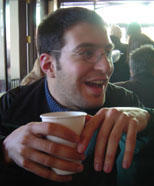I interviewed a former colleague of mine,
the crazy scientist. We discussed the next big thing in cell biology, his outlook for 2006 and his prospects at finding a job as a PI (principal investigator i.e. professor) ...
Mad Scientist says: How long after a vacation does it take before you are able to perform experiments?
Crazy Scientist says: Well, that is a very interesting question. When I leave, I plan ahead so that I can start an experiment as soon as I get back. The problem is that normally those experiments don't work because I end up making stupid mistakes. So in the end, only after 3-4 days, or a stupid mistake, am I able to run a decent experiment.
MS: It takes me about a week. As hard as I try it would seem that the forces of Nature are against me.
CS: For example I arrived Wednesday evening from Europe with a 5 hr jet-lag. Thursday morning I was running gels to test some serum I received during the holidays. Tuesday I realized I screwed up the experiment. Friday I had the result.
MS: At least the rabbit was working hard while you were away. How do you think this year (2006) will go for you?
CS: Very exciting. Since I'm in the job market, I am very excited to know where I will get the next interview, will I like the place, when will I move, etc.
MS: I'm glad that you are optimistic.
CS: Also, I am finishing up some exp for the next paper .
MS: So it sounds like 2006 will be a good year for you. Speaking of the new year, what do you predict will be the biggest discovery (in 2006) in Cell Biology?
CS: Uhm, that's easy. RNA transport from the nucleus (just kidding...)
MS: Wow I chose the right field!
CS: Ok, now for the right answer. I think a lot will be discovered about local regulation of cellular functions by small hairpin RNAs (shRNA), also known as micro RNAs (miRNA). These activate the turnover of mRNAs. Right now this field is very hot, but the field is limited to the role of shRNAs in development. There is some cell biology being done, but some questions such as whether degradation of mRNAs within a region of the cell can allow for local regulation of protein turnover are not yet addressed. This local protein control may contribute to generating different cell shapes and other morphological aspects. This will be very cool.
(Post interview note: for more on shRNAs and miRNAs,
click here.)
MS: So RNA is the place to be!
CS: It is a good place, however, remember that all starts in the nucleus, and that big ball is very fascinating ... and what do you think?
MS: I think that we've seen the genome, we've seen the transcriptome, the kinome, the proteome ... now it's time for the glycosylome! (as in glycosylation ... or the compiling of how sugars are added to proteins, and the different functions of each type of sugar modification)
CS: What about the phosphorylome? Can you imaging knocking-out one kinase at a time a measure phosphorylation of 100-1000 proteins?
MS: I think that too many people study phosphorylation. Two groups (one in our department) are doing that just that (the phosphorylome). The one in our department did mass spec and pulled out every phosphopeptide enriched in mitosis. There is also the ubiquitinome - but it's an oversaturated field as well.
CS: Good. They'll hopefully repeat it for each knock-down kinase.
MS: Maybe they can hire you! I think that if those systems biologists can get their act together, maybe getting some insights into how signaling "modules" work could be big in 2006. Speaking of jobs - what is the thing you look for when interviewing for positions?
CS: Critical mass. How smart and how interesting is the work of my future colleagues. That is the key thing.
MS: So interaction is the most important feature - is it better in large institutions, or smaller ones?
CS: You can find good group of people in small institutions and you can be completely alone in large ones. My experience with Columbia (a huge institution) is that you end up talking with the same 4-6 labs. So I think we cannot make a rule for that. The next important factor is the working conditions (space, core facilities, startup package, funding). The perfect situation is a big institution with a good core of 4-6 groups.
MS: I see - do you feel that as a scientist with a background in "live cell imaging" you have an advantage over other scientists (in that you have more to offer in your interactions with colleagues)?
CS: Not necessarily. I think every scientist have their "background" and their specific "advantage to offer". My background is not better than someone that has a protein-interaction background.
MS: But getting back to biggest areas in 2006 - more and more people are adapting their assays to microscopy - such as single molecule enzymology ... you do have some technical expertise that is not that widely spread.
CS: I guess depending on your question, some backgrounds are more suitable than others depending on the colleagues you find yourself with. Again interaction plays a very important role. (I have to go soon, one more question)
MS: What is the next big thing in cytoskeletal research? (I had to ask a big question since it's my last one)
CS: I think it will be the connection between actin and microtubules, and how this is involved in regulation of both cytoskeletons and their function. Some call it cytoskeletal cross-talk.
MS: I guess you're in the right field! It's funny, because this question has been studied for years, and we've made lots of progress, but it is one of the trickiest questions in all of Cell Biology.
CS: I guess so!
MS: Thanks for chatting. Have a good weekend.
CS: Thanks, you too.



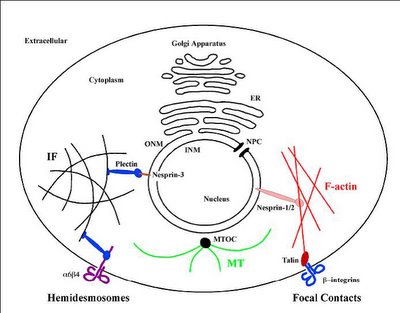


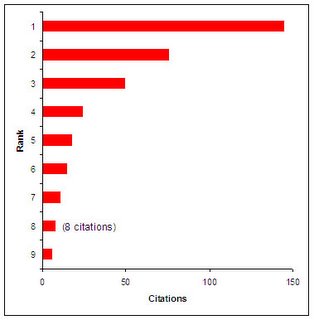


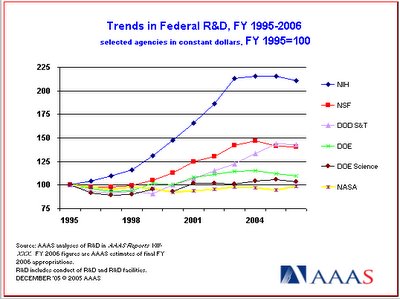
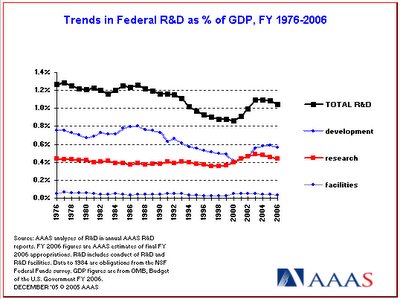 The future of funding for federal R&D programs? Here's the last paragraph of the report:
The future of funding for federal R&D programs? Here's the last paragraph of the report: